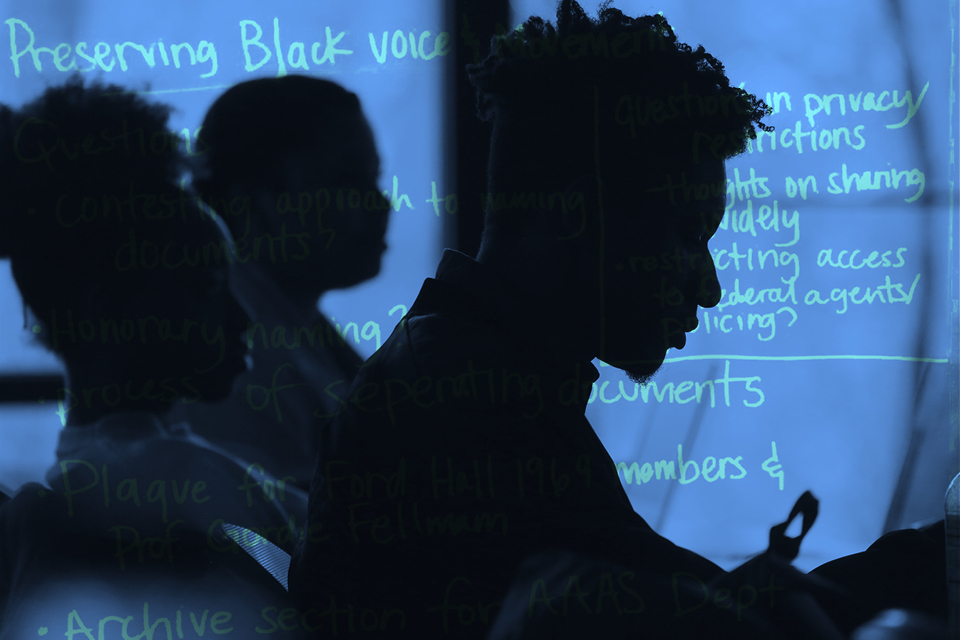A journey through Black space
 Photograph by Mike Lovett / illustration by Jessica Tanny
Photograph by Mike Lovett / illustration by Jessica TannyBrainstorming notes by Queen White ’16.
Not long after the Ford Hall 2015 protests at Brandeis, a group of students who were part of the 13-day sit-in connected with the Robert D. Farber University Archives and Special Collections.
The conversations started with questions about how to properly document the #FordHall2015 movement, but eventually grew to something bigger. They wanted to address the lack of visibility in the archives of the history of marginalized groups.
Queen White ’16, Chari Calloway ’20, and Wil Jones ’18 began meeting every week with Brandeis archivist Maggie McNeely and Micha Broadnax ’12, an archivist who worked at Emerson College at the time. The group formed the Brandeis BLK Archives Collective in 2016. A paid student worker position, archive assistant student liaison, was created. The Black Space Portal was conceived.
The portal is a website built by Jones and hosted by the Brandeis library that provides a place where the historical experience of people belonging to marginalized groups is presented by those who have lived a similar experience.
"It was a way for us to curate a space to commemorate Black existence at Brandeis," said Calloway. "It is important for people to piece together those narratives and curate them, but we didn't want them to be put forward by someone who wasn't directly part of it. It became a passion project."
Projects in the portal bring archival materials to the forefront in a way that is digitally accessible and easy to engage with.
"The idea behind it was to provide an access point where students of color could be encouraged to engage with the history of campus through different projects hosted on the portal," McNeely said. “Archives have not historically been good at bringing such material to the most relevant communities, so that is one of the challenges we set about to correct.”
Broadnax, now the project manager for the Black Teacher Archives, became involved somewhat serendipitously. She reached out to McNeely following the Ford Hall protests to find out how the university archives would be documenting the historic events of the sit-in and became involved in the conversations with McNeely and the students.
"Students are the most important voice on campus, and sometimes that can be lost in the historical record," Broadnax said.
The first project for the portal, created in 2017, was a detailed timeline of each day of the original Ford Hall protest in 1969. The second project chronicled Brandeis’ Black history, from the university’s founding in 1948 to 2018. It featured research by students in professor Chad Williams’ unique course developed for the 50th anniversary of the Brandeis African and African American studies department, “Black Brandeis, Black History” that was built into a timeline by Rai McKinley Terry '19, that year’s Archive Assistant Student Liaison.
Ellie Kleiman '21 was a student in the course who helped create the portal’s second project. During the class, she learned about the 1975 Pearlman Hall takeover, a protest by a coalition of Black, Asian and Latinx students demanding better treatment for low-income students of color that was inspired by the Ford Hall protest in 1969. The coalition included the Brandeis Asian American Students Association, and adding Asian Americans to the minority financial aid pool was part of the demands. She had to know more.
“As an Asian-American student myself, I was looking for moments of history like this and was interested in the legacy of Asian students,” Kleiman said. “I realized there's so much material there that we didn't have time to cover in class and uncover and analyze.”
Kleiman approached the archives, and has since closely documented the six-day protest. She dug through newspaper archives and interviewed participants in the protest to create a digital zine and article, published in February, on the takeover that is hosted on the Black Space Portal.
Each of the projects on the portal has the power to make people feel the moment in a deeper, more meaningful way, Calloway said. She hopes in the future the portal will highlight the voices of Black queer people and their role in activism on campus.
"When you can hold something or see a letter, see a real artifact, you hold the weight of that moment,” Calloway said. “It's powerful. It can be life-changing."
Categories: Research, Student Life





